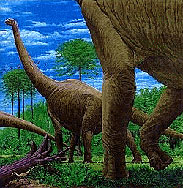Argentinosaurus Huinculensis See map
The Argentinosaurus had an estimated weight of 100 tons (a male African elephant can weigh up to 7 tons) so you can safely consider that it was a slow-moving animal, but not clumsy.
 Argentinosaurus Huinculensis.
Argentinosaurus Huinculensis.The vertebraes of 1.65 meters high were articulated together by complex interlocking structures to support that weight.
The Argentinosaurus came to measure up to 40 meters long and lived about 65 million years ago (Upper Cretaceous) in the area of Plaza Huincul and Cutral Co, in the province of Neuquén. Like all large sauropods, it fed on the foliage of tall trees.
Viajes por la Patagonia
Related Articles
Patagonia is a rich field for Paleontology For more than 100 million years ago dinosaurs roamed the earth. Patagonia is one of the most rich in traces of their existence.
Alvaresaurios Calvoi El Alvaresaurio Calvoi is an avian dinosaur found in the walls of the city of Neuquén. Bones and a natural size replica are exhibited in the museum of the National University of Comahue.
Amargasaurus Casuei The Amargasaurus Cazuei was a sauropod (plant-eating animal) that had the peculiarity of spines on the back and head, which protected him from attack by large predators that doubled in size.
Andesaurious Delgadoi The Andesaurious Delgadoi or "lizard of the Andes" is a kind of titanosaur (herbivore) found in the area of Comahue. Its fossils are on display in the museum of the National University of Comahue.
Carnotaurus Sastrei El Toro Carnivore (Carnotaurus) was one of the fearsome predators of the Cretaceous period. Its fossils are on display at the Museum of Natural Sciences in Buenos Aires and at the Museum Egidio Feruglio of Trelew.
Gigantosaurus Carolini The Carolini Giganotosaurus is the largest carnivorous dinosaur in the world. The bones of the dinosaur, and a replica made of resin size, are displayed in the municipal museum of Villa El Chocón.
Rebachisaurus Tessonei The Rebachisaurus Tessonei was a sauropod that walked on four legs and had a long neck ranged between 15 and 17 meters and its weight is estimated between 18 and 20 tonnes.
Unenlagia Comahuensis It is the ancestor of the oldest flying bird known. Its name (in Mapuche language) means something like "half bird of the Comahue" and its fossils were found by paleontologist Fernando Novas in the place Portezuelo, on the border between Cutral Có and Zapala.
See all Articles
Hoteles | Viajes | Fotogalería | Legales | Contáctenos | Comercial
© Patagonia.com.ar 2026 | Todos los derechos reservados.
© Patagonia.com.ar 2026 | Todos los derechos reservados.
